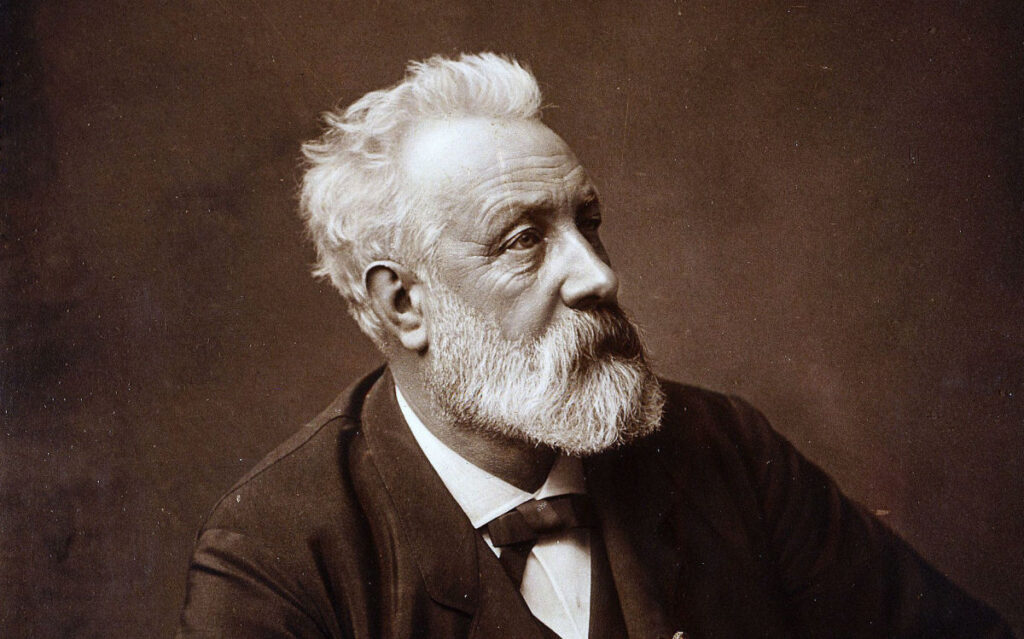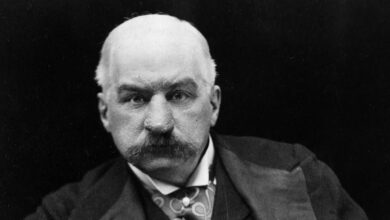
Podcast: Play in new window | Download
Subscribe: Spotify | Amazon Music | Youtube Music | RSS
“Science, my lad, is made up of mistakes, but they are mistakes which it is useful to make, because they lead little by little to the truth.” – Jules Verne
Jules Gabriel Verne was born on 8 February 1828 on Île Feydeau, which was a small man-made island which sits within the boundaries of the town of Nantes on the River Loire in France. It no longer exists as an island as the river was re-filled in the 1930s, but the area has retained the name.
He was the eldest of five siblings and was born in his grandmother’s house at No. 4 Rue Olivier-de-Clisson to parents, Pierre Verne who was a lawyer and Sophie Allote de la Fuÿe, a local woman with Scottish ancestry whose family were shipowners. Paul, Jules’ brother was born in 1829 and three sisters, Anna, Mathilde and Marie followed in 1836, 1839 and 1842.
When he was six years old, Jules was sent to boarding school in Nantes where he would receive inspiration for future stories such as The Mysterious Island and The School for Robinsons from his teacher, Madame Sambin who told her students that her husband was a naval captain and that he had disappeared over thirty years previously and that she believed he had been shipwrecked and was living in a desert island paradise and that one day he would return, just like Robinson Crusoe.
Two years later, Jules went to a Catholic school called École Saint‑Stanislas where he was found to be more than proficient in geography, Greek, Latin and singing. He was noted to also be especially good at reciting information from memory.
From this early age, Jules was fascinated by the comings and goings on the river and wondered what it would be like to be on board the ships, travelling to strange new lands. He often took holidays with his uncle Prudent Allotte who was a retired shipowner who told him stories of his adventures travelling around the world.
It is thought that in 1839 when he was only 11 years old Jules secured the position of cabin boy on board a ship which was to sail to the Indies but he was stopped just before the ship sailed by his father who told him to travel only in his imagination. It is unclear if the story is true, but it illustrates how fascinated the young Verne was with sea travel.
In 1842 Jules Verne moved to another religious school but this one he didn’t enjoy at all, recounting his experiences in an unfinished novel called Un prêtre (A Priest) in 1839, the earliest known piece of Jules Verne prose that is known to exist. Two years later, he and his brother attended the Lycée Royal which is now known as the Lycée Georges-Clemenceau in Nantes. He studied philosophy and rhetoric and received a grade of “good enough” when he sat the baccalauréat exam on 29 July 1846.
The following year, when Jules turned 19 it started to become clear that he was taking a serious interest in writing but his father preferred him to follow in his footsteps and so sent him to Paris to study law. He passed his first-year exams and returned to Nantes so that his father could prepare him for his second year, and it was during this time that he met and fell deeply in love with Rose Herminie Arnaud Grossetière. He wrote numerous poems for her, and although she seemed interested, her parents were not, preferring instead that she marry a rich landowner who was ten years older than her, which she did in 1848. Jules described his misery at this outcome in a letter to his mother and there are examples of young women being married against their will in several of his novels, including Master Zacharius, Mathias Sandorf and A Floating City which was published in 1871.
In July 1848, Jules Verne returned to Paris with the intent of completing his law studies but he found the city in turmoil with the Revolution of 1848 in full swing following the overthrow of King Louis Philippe. He continued with his law studies but also used his connections to become more acquainted with Parisian society. He was introduced to literary salons and wrote several plays, being heavily influenced by the work of Victor Hugo.
His letters home were primarily concerned with his living expenses but he also indicated certain health problems he was suffering from, including stomach cramps, which were probably due to colitis and bouts of facial paralysis. At around the same time, Verne was required to enlist for military service, and this would have caused him problems as it was clear in his letters that he was strongly opposed to war. However, the sortition process resulted in him never actually needing to serve, much to his relief.
In January 1851, Jules Verne graduated law school with a ‘licence en droit’, which allowed him to give legal advice.
However, it was soon clear that the law was not going to be the career path that Jules Verne would choose. He had met Alexandre Dumas in 1849 and became close friends with his son and the two worked on an idea for a comedy play that Verne had come up with called The Broken Straws. With help from the elder Dumas, the play opened in Paris on 12 June 1850.
Around the same time, Verne started to write short adventure stories including The First Ships of the Mexican Navy and A Voyage in a Balloon which were published through Pitre-Chevalier. The latter of these was identified by Verne himself as the first of the type of story that he would become known for.
In 1852, Verne was forced into making a decision – whether to continue with his passion for literature or to practice law, following an offer from his father to set up a law practice for him in Nantes. His passion for literature won, and the idea of him ever practising law was put to bed.
As he continued to write adventure novels for Pitre-Chevalier he hit on the idea of including science-based facts within his novels and so he increased the amount of research he was doing through the use of libraries and also through conversations with people who had travelled the world.
During a trip to Amiens in 1856 to attend the wedding of his friend Auguste Lelarge, Jules Verne was invited to stay with the bride’s family whereupon he met and fell in love with her sister, Honorine de Viane Morel, who was already a widow with two children at the age of 26. The couple were married on 10 January 1857. They had one child; a son called Michel who was born on 3 August 1861.
Around the same time, he had been working on an idea for his first novel, which was inspired by his love of maps and the stories told by the world’s greatest explorers. The novel, which was called Five Weeks in a Balloon, was published in 1863 by Pierre-Jules Hetzel who was in the process of setting up a new magazine called the Magazine of Education and Recreation and he offered Verne a contract which would require him to submit at least three pieces of work per year which Hetzel would purchase and publish in the magazine. The thought of a regular income was appealing and so Verne agreed. From that point on, most of Jules Verne’s novels were serialised in the magazine before they appeared as books.
Verne’s relationship with Hetzel had been one in which he readily adopted any changes or suggestions for improvement that Hetzel made. However, the two had a significant disagreement over the manuscript for 20,000 Leagues Under the Sea as Hetzel wanted to change the background of the main character, Captain Nemo, so as not to upset the lucrative Russian market. The two ultimately reached a compromise, but Verne was less than enthusiastic about making changes in future work and in some cases flat out refused to do so. Nevertheless, Verne continued to publish at least two novels per year and they included some of his best-known work such as Journey to the Centre of the Earth, From the Earth to the Moon, and Around the World in Eighty Days and as his income increased, he was able to indulge in some travel adventures of his own when in 1867 he bought a boat that he called Saint-Michel, which he enjoyed sailing around Europe.
On 9 March 1886, as Jules Verne was travelling home, he was shot at by his nephew Gaston. One of the bullets hit Verne in the leg, resulting in him sporting a limp for the rest of his life. The incident was hushed up and Gaston spent the rest of his life in a mental asylum. During the latter part of his life Jules Verne suffered from Diabetes and on 24 March 1905 at his home in Amiens, he died at the age of 77. His novels continued to be published, albeit with extensive changes at the rate of 2 per year by his son Michel, with the original versions being published by the Jules Verne Society at the end of the 20th century.
Podcast: Play in new window | Download
Subscribe: Spotify | Amazon Music | Youtube Music | RSS




